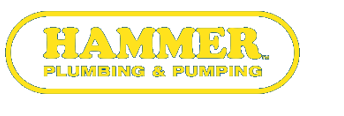.
We at Hammer understand there are many questions about plumbing, finding a good plumber and contractor, and so much more. We will be continually updating our FAQ section to try and answer those questions and help you along the way.
If you have a question that you think may be helpful to answer here, please send us a message.
Kitchen Plumbing
We have all experienced a stopped up sink and the frustration that goes along with it. Most stopped up sinks are easily solved with a drain cleaning liquid or even a plunger. If these options don’t work then the next step is to remove the “P trap” which is located directly under the sink. It is a “U” or horizontal “P” shaped pipe. This is usually easily removed by hand. Make sure you remove any supplies you have under the sink because they are likely to get wet. You should also have a bucket so that when you remove the pipe the water has a place to drain. If the sink is a kitchen sink and completely full then you should cup or scoop out the water and dump it into a drain that is flowing. Once the “P” trap is removed look into pipe and verify it is clean. If there is no blockage in the “P” trap then you should probalbly give us a call because the line will need hydro – jetting or snaking.
Bathroom Plumbing
We have all experienced a plugged toilet and the frustration that goes along with it. Most toilet plug are easily solved with a plunger. The frustration is when you don’t have one. I recommend getting at least plunger for your house or one for each bathroom is even better. This can save embarrassment for your guests if it happens when they are visiting.
Now if that doesn’t work you can then try a toilet auger which can purchased at Lowes or Home Depot. However, you must take not to scratch your toilet when using this tool. If the auger doesn’t work you may want to determine if it is just the toilet or is it the main line. This can be done running water in the tub and or shower then flushing the toilet to see if it comes up in the tub or shower. ( sounds gross, huh?). The only problem with doing this is it could cause a mess.
If all of this sounds too difficult to deal with, then just give us call we would love to help you out.
Septic Systems
Download our PDF illustration of a Septic System
A Septic System is the combination of a Septic Tank and a Leaching System. A Leaching System might be Leach Lines, Leach Beds or Seepage Pits. Sometimes the term “Cesspool” is used. Technically, a Cesspool has no Septic Tank upstream and are against current code. Seepage Pits are also referred to as “Drywells”. However, Drywells typically handle no sewage. Drywells are used to re-introduce storm water into the ground.
Everything from the home first enters at the top portion of the Septic Tank through the inlet “T” and exits at the top portion of the tank through the outlet “T”. It is in this liquid environment that bacteria do its work of breaking down most solids into a liquid called effluent. Effluent exits the tank and enters the leaching system where it percolates (seeps) back into the ground. The Septic Tank separate the solids from the water through detention time. Septic Tanks are designed to handle all the normal, daily (24 Hour) effluent flow which a household can produce. There are advantages to installing a larger Septic Tank. Longer detention times, (due to the larger capacity), permit better separation and less carry-over of scum and sludge and tend to prolong the life of the leaching system.
The Riverside County Health department recommends every 3 years for single family homes. It really depends on how many people live there. We recommend every 3 to 5 years. Servicing a septic system is a lot like changing the oil on a car. For instance, you could probably drive your car without changing the oil for 50,000 miles but that would significantly reduce the life of your engine. In a septic system the seepage pit is like the engine. In order to extend the life of your seepage pit you need to remove the solids from the septic tank on regular basis to prevent solids from migrating to the pit and plugging the holes and clogging the gravel that allows the water to seep into the ground. The more often you pump your tank the longer your leaching system will last.
If you are told by your septic technician that your system is failing it means that your leaching system is not percolating. In other words you are putting water down the drain and into your septic system faster than the water is soaking into the ground.
There are several options at different levels of cost that are available. You can either put in a new leaching system, hook to city sewer, cut water usage, and or bio-remediation treatment. Of course the most permanent solution is hooking to city sewer. However, often times city sewer is unavailable. The next best solution is installing a new seepage pit or leach line. The final most popular and lowest cost option is cutting back on water usage in the house. You can also do a bio remediation bacteria treatment that is designed to increase percolation.
All systems will fail at some point. The best thing you can do to increase the life of your leaching system is limit water going down the drain and keep your system pumped. When showering, brushing teeth, doing laundry or dishes be aware and concerned about the amount of water your using. You can also install water saving fixtures that can drastically reduce water usage. Call us for a free consultation on how to save water.
